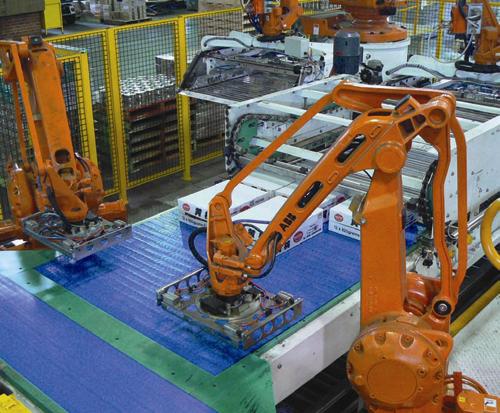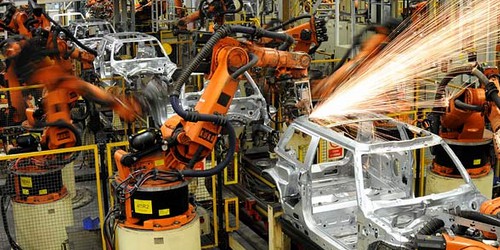Today most robots are made use of in manufacturing procedures; the applications could be broken down right into three classifications: (1) material handling, (2) processing operations, and (3) setting up and also assessment.
Material-handling applications consist of material transfer and also equipment loading as well as unloading. Material-transfer applications need the robotic to move materials or work parts from one area to an additional. Many of these tasks are reasonably easy, requiring robots to get parts from one conveyor as well as place them on another. Other transfer procedures are more complex, such as positioning components over pallets in a setup that have to be calculated by the robotic. Equipment loading and discharging procedures use a robotic to lots as well as discharge components at production equipment. This calls for the robotic to be equipped with a gripper that can realize components. Typically the gripper has to be designed specifically for the particular part geometry.
In robotic processing operations, the robotic controls a tool to carry out a procedure on the work component. Examples of such applications consist of place welding, continuous arc welding, and spray paint. Place welding of automobile bodies is among the most typical applications of industrial robots in the United States. The robot positions an area welder versus the vehicle panels as well as structures to complete the setting up of the basic automobile physical body. Arc welding is a constant procedure where the robot relocates the welding pole along the joint to be welded. Spray painting involves the adjustment of a spray-painting weapon over the surface area of the object to be covered. Various other procedures in this category consist of grinding, polishing, and also transmitting, where a revolving pin serves as the robotics’ device.
The third application location of commercial robots is setting up and evaluation. Using robots in assembly is anticipated to enhance as a result of the high expense of hands-on labour usual in these operations. Since robots are programmable, one strategy in assembly job is to make several product styles in sets, reprogramming the robots between sets. A different strategy is to make a mix of various product styles in the exact same assembly cell, requiring each robotic in the cell to recognize the product design as it arrives and then execute the ideal activity for that system.
The layout of the item is an essential element of robot setting up. Setting up methods that are sufficient for humans are not necessarily appropriate for robots. Using a screw and nut as a fastening method, for instance, is easily carried out in hand-operated assembly, but the very same procedure is exceptionally difficult for a one-armed robotic. Designs in which the elements are to be included from the very same instructions using snap fits and also various other one-step fastening treatments allow the job to be completed much more effortlessly by automat iced and robot assembly techniques.
Evaluation is another location of manufacturing facility operations in which the usage of robots is growing. In a typical assessment job, the robotic positions a sensor with respect to the work component and also determines whether the part is consistent with the high quality requirements.
In almost all commercial robot applications, the robotic gives a replacement for human labour. There are certain qualities of commercial jobs performed by people that determine the work as a potential application for robots: (1) the procedure is repeated, entailing the very same standard work motions every cycle; (2) the operation is unsafe or uneasy for the human worker (e.g., spray paint, place welding, arc welding, and particular equipment loading as well as unloading activities); (3) the job calls for a job component or technique that is heavy as well as uncomfortable to deal with; and (4) the procedure permits the robotic to be utilized on 2 or 3 changes.
Flexible manufacturing systems
A versatile production system (FMS) is a kind of versatile automation in which a number of device devices are linked together by a material-handling system, and all aspects of the system are managed by a main computer system. An FMS is differentiated from a computerized production line by its ability to refine more than one item style all at once. Anytime, each machine in the system may be processing a various component kind. An FMS could likewise handle changes in item mix as well as manufacturing schedule as demand designs for the various products made on the system modification gradually. New item designs can be introduced into manufacturing with an FMS, as long as they broken within the range of products that the system is developed to process. This type of system is as a result excellent when demand for the products is low to tool as well as there is most likely to be adjustments popular.
The elements of an FMS are (1) processing equipments, which are typically CNC device techniques that do machining operations, although various other kinds of automated workstations such as examination terminals are likewise feasible, (2) a material-handling system, such as a conveyor system, which can providing job parts to any kind of machine in the FMS, and also (3) a main computer system that is responsible for connecting NC part programs to each device and also for collaborating the activities of the equipments as well as the material-handling system. On top of that, a fourth element of an FMS is human labour. Although the versatile production system stands for a high level of production automation, people are still needed to take care of the system, tons and also unload components, modification devices, and also preserve as well as repair the tools.



